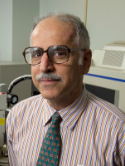NMR solution structure of an oligodeoxynucleotide duplex containing the exocyclic lesion 3,N(4)-etheno-2'-deoxycytidine opposite thymidine: Comparison with the duplex containing deoxyadenosine opposite the adduct Journal Article
| Authors: | Cullinan, D.; Korobka, A.; Grollman, A. P.; Patel, D. J.; Eisenberg, M.; de los Santos, C. |
| Article Title: | NMR solution structure of an oligodeoxynucleotide duplex containing the exocyclic lesion 3,N(4)-etheno-2'-deoxycytidine opposite thymidine: Comparison with the duplex containing deoxyadenosine opposite the adduct |
| Abstract: | The exocyclic 3,N4-etheno-2'-deoxycytidine adduct was incorporated at the center of the oligodeoxynucleotide duplex d(C-G-T-A-C-εC-C-A-T-G-C)- d(G-C-A-T-G-T-G-T-A-C-G), and its solution structure was analyzed using high- resolution proton NMR spectroscopy and molecular dynamics simulations. The experimental data indicate that the oligodeoxynucleotide duplex adopts a right-handed helical structure with sugar puckers in the C2'-endo/C3'-exo range and Watson-Crick hydrogen bond alignments for all base pairs. NOE connectivities established a syn orientation for the glycosidic torsion angle of the exocyclic adduct. Restrained molecular dynamics simulations, using the full relaxation matrix approach, produced a three-dimensional model in agreement with the experimental data. The structure shows only minor perturbations in the sugar-phosphate backbone and a 27° bend of the helical axis at the lesion site. On the refined model a well-formed hydrogen bond between T(N3H) and εC(N4) stabilizes the εC(syn)-T(anti) base pair alignment, reflecting the preference of the adduct for the syn orientation. Furthermore, the εC(syn)-T(anti) base pair stacks with flanking base pairs. We discuss a correlation between the mutagenic properties of the adduct and the three-dimensional structure of the εC-dA and εC-T duplexes. |
| Keywords: | dna damage; molecular dynamics; double stranded dna; magnetic resonance spectroscopy; base sequence; dna adduct; dna flanking region; dna structure; dna adducts; hydrogen bonding; models, molecular; protons; solutions; thermodynamics; molecular structure; nucleic acid conformation; dna helix; deoxycytidine; nuclear magnetic resonance; mutagenesis; oligodeoxynucleotide; thymidine; oligodeoxyribonucleotides; nucleic acid base substitution; nuclear overhauser effect; base composition; deoxyadenosine; priority journal; article; deoxyadenosines |
| Journal Title: | Biochemistry |
| Volume: | 35 |
| Issue: | 41 |
| ISSN: | 0006-2960 |
| Publisher: | American Chemical Society |
| Date Published: | 1996-10-15 |
| Start Page: | 13319 |
| End Page: | 13327 |
| Language: | English |
| DOI: | 10.1021/bi9605705 |
| PUBMED: | 8873598 |
| PROVIDER: | scopus |
| DOI/URL: | |
| Notes: | Article -- Export Date: 22 November 2017 -- Source: Scopus |



